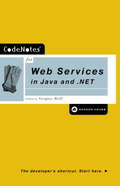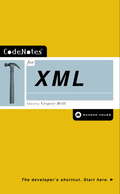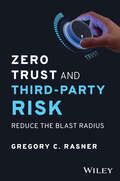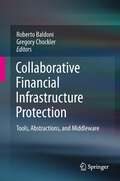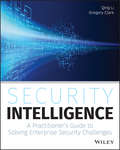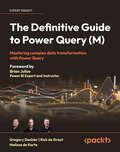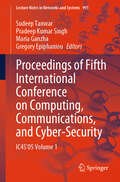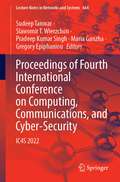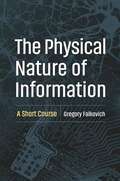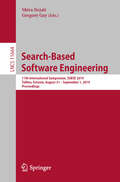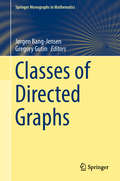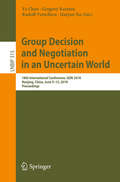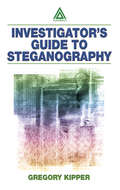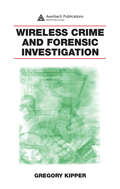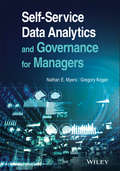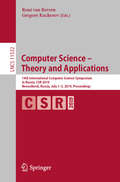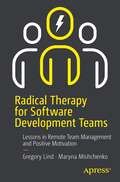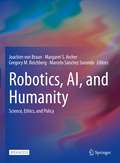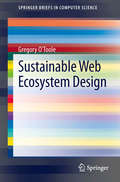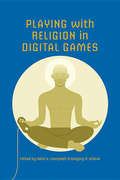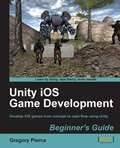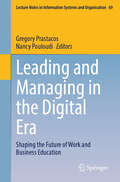- Table View
- List View
CodeNotes for Web Services in Java and .NET
by Gregory BrillCodeNotes provides the most succinct, accurate, and speedy way for a developer to ramp up on a new technology or language. Unlike other programming books, CodeNotes drills down to the core aspects of a technology, focusing on the key elements needed in order to understand it quickly and implement it immediately. It is a unique resource for developers, filling the gap between comprehensive manuals and pocket references. CodeNotes for Web Services in Java and . NET examines the core specifications and technologies required for building SOAP-based web services in both Java and . NET. Not only will you find descriptions of SOAP, WSDL, and UDDI; you will also see how to use each of these specifications with Java and . NET. In addition, you will find specific sections on cross-language and cross-platform compatibility between web services. This edition of CodeNotes includes: * A global overview of this technology and explanation of what problems it can be used to solve * Real-world examples * "How and Why" sections that provide hints, tricks, workarounds, and tips on what should be taken advantage of or avoided * Instructions and classroom-style tutorials throughout from expert trainers and software developers
CodeNotes for XML
by Gregory BrillCodeNotes provides the most succinct, accurate, and speedy way for a developer to ramp up on a new technology or language. Unlike other programming books, CodeNotes drills down to the core aspects of a technology, focusing on the key elements needed in order to understand it quickly and implement it immediately. It is a unique resource for developers, filling the gap between comprehensive manuals and pocket references.CodeNotes for XML is a practical handbook for Java and Visual Basic developers interested in working with XML. You will learn how to leverage both CSS and XSLT to produce rich, compelling output, as well as manipulate XML using the DOM and SAX APIs. The new XML Schema specification is also covered in-depth. Companion articles on www.codenotes.com cover XML development with Perl, integrating XML with databases, important grammars such as XHTML and SOAP, and much more. CodeNotes for XML is your guide to these powerful technologies, presented within the context of the distributed application, database, or web-based world you already know. This edition of CodeNotes includes:-A global overview of a technology and explanation of what problems it can be used to solve-Real-world examples-"How and Why" and "Bugs and Caveats" sections that provide hints, tricks, workarounds, and tips on what should be taken advantage of or avoided-Instructions and classroom-style tutorials throughout from expert trainers and software developers.Visit www.codenotes.com for updates, source code templates, access to message boards, and discussion of specific problems with CodeNotes authors and other developers.Every CodeNotes title is written and reviewed by a team of commercial software developers and technology experts. See "About the Authors" for more information.
Cybersecurity and Third-Party Risk: Third Party Threat Hunting
by Gregory C. RasnerSTRENGTHEN THE WEAKEST LINKS IN YOUR CYBERSECURITY CHAINAcross the world, the networks of hundreds of different world-class organizations have been breached in a seemingly never-ending stream of attacks that targeted the trusted vendors of major brands. From Target to Equifax, Home Depot, and GM, it seems as if no company is safe from a third-party incident or breach, regardless of size. And the advanced threats are now exploiting the intersection of weaknesses in cybersecurity and third-party risk management.In Cybersecurity and Third-Party Risk, veteran cybersecurity specialist Gregory Rasner walks readers through how to lock down the vulnerabilities posed to an organization’s network by third parties. You’ll discover how to move beyond a simple checklist and create an active, effective, and continuous system of third-party cybersecurity risk mitigation.The author discusses how to conduct due diligence on the third parties connected to your company’s networks and how to keep your information about them current and reliable. You’ll learn about the language you need to look for in a third-party data contract whether you’re offshoring or outsourcing data security arrangements.Perfect for professionals and executives responsible for securing their organizations’ systems against external threats, Cybersecurity and Third-Party Risk is an indispensable resource for all business leaders who seek to:Understand the fundamentals of third-party risk managementConduct robust intake and ongoing due diligencePerform on-site due diligence and close vendor risksSecure your software supply chainUtilize cloud and on-premises software securelyContinuously monitor your third-party vendors and prevent breaches
Zero Trust and Third-Party Risk: Reduce the Blast Radius
by Gregory C. RasnerDramatically lower the cyber risk posed by third-party software and vendors in your organization In Zero Trust and Third-Party Risk, veteran cybersecurity leader Gregory Rasner delivers an accessible and authoritative walkthrough of the fundamentals and finer points of the zero trust philosophy and its application to the mitigation of third-party cyber risk. In this book, you’ll explore how to build a zero trust program and nurture it to maturity. You will also learn how and why zero trust is so effective in reducing third-party cybersecurity risk. The author uses the story of a fictional organization—KC Enterprises—to illustrate the real-world application of zero trust principles. He takes you through a full zero trust implementation cycle, from initial breach to cybersecurity program maintenance and upkeep. You’ll also find: Explanations of the processes, controls, and programs that make up the zero trust doctrine Descriptions of the five pillars of implementing zero trust with third-party vendors Numerous examples, use-cases, and stories that highlight the real-world utility of zero trustAn essential resource for board members, executives, managers, and other business leaders, Zero Trust and Third-Party Risk will also earn a place on the bookshelves of technical and cybersecurity practitioners, as well as compliance professionals seeking effective strategies to dramatically lower cyber risk.
Collaborative Financial Infrastructure Protection: Tools, Abstractions, and Middleware
by Gregory Chockler Roberto BaldoniThe Critical Infrastructure Protection Survey recently released by Symantec found that 53% of interviewed IT security experts from international companies experienced at least ten cyber attacks in the last five years, and financial institutions were often subject to some of the most sophisticated and large-scale cyber attacks and frauds. The book by Baldoni and Chockler analyzes the structure of software infrastructures found in the financial domain, their vulnerabilities to cyber attacks and the existing protection mechanisms. It then shows the advantages of sharing information among financial players in order to detect and quickly react to cyber attacks. Various aspects associated with information sharing are investigated from the organizational, cultural and legislative perspectives. The presentation is organized in two parts: Part I explores general issues associated with information sharing in the financial sector and is intended to set the stage for the vertical IT middleware solution proposed in Part II. Nonetheless, it is self-contained and details a survey of various types of critical infrastructure along with their vulnerability analysis, which has not yet appeared in a textbook-style publication elsewhere. Part II then presents the CoMiFin middleware for collaborative protection of the financial infrastructure. The material is presented in an accessible style and does not require specific prerequisites. It appeals to both researchers in the areas of security, distributed systems, and event processing working on new protection mechanisms, and practitioners looking for a state-of-the-art middleware technology to enhance the security of their critical infrastructures in e.g. banking, military, and other highly sensitive applications. The latter group will especially appreciate the concrete usage scenarios included.
Security Intelligence
by Gregory Clark Qing LiSimilar to unraveling a math word problem, Security Intelligence: A Practitioner's Guide to Solving Enterprise Security Challenges guides you through a deciphering process that translates each security goal into a set of security variables, substitutes each variable with a specific security technology domain, formulates the equation that is the deployment strategy, then verifies the solution against the original problem by analyzing security incidents and mining hidden breaches, ultimately refines the security formula iteratively in a perpetual cycle. You will learn about: Secure proxies - the necessary extension of the endpoints Application identification and control - visualize the threats Malnets - where is the source of infection and who are the pathogens Identify the security breach - who was the victim and what was the lure Security in Mobile computing - SNAFU With this book, you will be able to: Identify the relevant solutions to secure the infrastructure Construct policies that provide flexibility to the users so to ensure productivity Deploy effective defenses against the ever evolving web threats Implement solutions that are compliant to relevant rules and regulations Offer insight to developers who are building new security solutions and products
The Definitive Guide to Power Query (M): Mastering complex data transformation with Power Query
by Rick de Groot Melissa de Korte Gregory DecklerLearn how to use the Power Query M formula language and its functions effectively for better data modeling and impactful business intelligence reports. Purchase of the print or Kindle book includes a free PDF eBookKey FeaturesGet comprehensive coverage of fundamental and advanced Power Query conceptsGain hands-on experience with practical examples based on real-world problemsDelve into the intricacies of Power Query M language for enhanced data manipulationBook DescriptionData transformation is a critical step in building data models and business intelligence reports. Power Query is an invaluable tool for anyone who wants to master data transformation, and this book will equip you with the knowledge and skills to make the most of it. The Definitive Guide to Power Query (M) will help you build a solid foundation in the Power Query M language. As you progress through the chapters, you'll learn how to use that knowledge to implement advanced concepts and data transformations. This will set the stage for an uncompromisingly thorough exploration of the Power Query M Language. You'll also get to grips with optimizing performance, handling errors, and implementing efficient data processing techniques. As this is a hands-on guide, the practical examples in the chapters will help you gain the skills to apply Power Query to real-world problems and improve your data analysis capabilities. By the end of this book, you will be able to leverage all of Power Query's remarkable capabilities for data transformation.What you will learnGain a strong understanding of Power Query fundamentalsMaster various functions within Power Query to perform complex data operationsAcquire knowledge about values, types, and control structures in Power QueryDevelop proficiency in error handling techniquesLearn performance optimization strategies for Power QueryApply what you've learned to real-world scenarios, including common troublesome patternsWho this book is forThis book is for business analysts, business intelligence professionals, and power business users working with data who want to add Power Query mastery to their resume. This book will be beneficial for anyone who wants to automate their process of data cleaning and save huge amount of time. Having some basic experience in Power Query is recommended.
Proceedings of Fifth International Conference on Computing, Communications, and Cyber-Security: IC4S'05 Volume 2 (Lecture Notes in Networks and Systems #1128)
by Pradeep Kumar Singh Gregory Epiphaniou Sudeep Tanwar Paulo J. Sequeira GonçalvesThis book features selected research papers presented at the Fifth International Conference on Computing, Communications, and Cyber-Security (IC4S'05) Volume 2, organized in India, during 8th–9th April, 2024. The conference was hosted at GEHU, Bhimtal Campus in India . It includes innovative work from researchers, leading innovators, and professionals in the areas of communication and network technologies, advanced computing technologies, data analytics and intelligent learning, the latest electrical and electronics trends, and security and privacy issues. The work is presented in two volumes.
Proceedings of Fifth International Conference on Computing, Communications, and Cyber-Security: IC4S’05 Volume 1 (Lecture Notes in Networks and Systems #991)
by Pradeep Kumar Singh Gregory Epiphaniou Sudeep Tanwar Maria GanzhaThis book features selected research papers presented at the Fifth International Conference on Computing, Communications, and Cyber-Security (IC4S 2023), organized in Ghaziabad India, during December 1–2, 2023. The conference was hosted at KEC Ghaziabad and Lisbon, Portugal. It includes innovative work from researchers, leading innovators, and professionals in the areas of communication and network technologies, advanced computing technologies, data analytics and intelligent learning, the latest electrical and electronics trends, and security and privacy issues. The work is presented in two volumes.
Proceedings of Fourth International Conference on Computing, Communications, and Cyber-Security: IC4S 2022 (Lecture Notes in Networks and Systems #664)
by Pradeep Kumar Singh Gregory Epiphaniou Sudeep Tanwar Maria Ganzha Slawomir T. WierzchonThis book features selected research papers presented at the Fourth International Conference on Computing, Communications, and Cyber-Security (IC4S 2022), organized in Ghaziabad India, during October 21–22, 2022. The conference was hosted at KEC Ghaziabad in collaboration with WSG Poland, SFU Russia, & CSRL India. It includes innovative work from researchers, leading innovators, and professionals in the area of communication and network technologies, advanced computing technologies, data analytics and intelligent learning, the latest electrical and electronics trends, and security and privacy issues.
The Physical Nature of Information: A Short Course
by Gregory FalkovichApplications of information theory span a broad range of disciplines today. This book presents a unified treatment of the subject for students and practitioners in the sciences. It teaches the tools universally used by physicists working on quantum computers and black holes, engineers designing self-driving cars, traders perfecting market strategies, chemists playing with molecules, biologists studying cells and living beings, linguists analyzing languages, and neuroscientists figuring out how the brain works. No matter what area of science you specialize in, The Physical Nature of Information unlocks the power of information theory to test the limits imposed by uncertainty. Provides a panoramic approach to information theory Draws on examples from physics, engineering, biology, economics, and linguistics Applications range from thermodynamics and statistical mechanics to dynamical chaos, information and communication theories, and quantum information Includes materials for lectures and tutorials along with exercises with detailed solutions Can be used to design a one-semester introductory course Ideal for self-study by graduate students and advanced undergraduates Invaluable for scholars seeking new research opportunities
Search-Based Software Engineering: 11th International Symposium, SSBSE 2019, Tallinn, Estonia, August 31 – September 1, 2019, Proceedings (Lecture Notes in Computer Science #11664)
by Shiva Nejati Gregory GayThis book constitutes the refereed proceedings of the 11th International Symposium on Search-Based Software Engineering, SSBSE 2019, held in Tallinn, Estonia, in August/September 2019. The 9 research papers and 3 short papers presented together with 1 keynote and 1 challenge paper were carefully reviewed and selected from 28 submissions. SSBSE is a research area focused on the formulation of software engineering problems as search problems, and the subsequent use of complex heuristic techniques to attain optimal solutions to such problems. A wealth of engineering challenges - from test generation, to design refactoring, to process organization - can be solved efficiently through the application of automated optimization techniques. SBSE is a growing field - sitting at the crossroads between AI, machine learning, and software engineering - and SBSE techniques have begun to attain human-competitive results.
Classes of Directed Graphs (Springer Monographs in Mathematics)
by Jørgen Bang-Jensen Gregory GutinThis edited volume offers a detailed account of the theory of directed graphs from the perspective of important classes of digraphs, with each chapter written by experts on the topic. Outlining fundamental discoveries and new results obtained over recent years, this book provides a comprehensive overview of the latest research in the field. It covers core new results on each of the classes discussed, including chapters on tournaments, planar digraphs, acyclic digraphs, Euler digraphs, graph products, directed width parameters, and algorithms. Detailed indices ease navigation while more than 120 open problems and conjectures ensure that readers are immersed in all aspects of the field. Classes of Directed Graphs provides a valuable reference for graduate students and researchers in computer science, mathematics and operations research. As digraphs are an important modelling tool in other areas of research, this book will also be a useful resource to researchers working in bioinformatics, chemoinformatics, sociology, physics, medicine, etc.
Group Decision and Negotiation in an Uncertain World: 18th International Conference, GDN 2018, Nanjing, China, June 9-13, 2018, Proceedings (Lecture Notes in Business Information Processing #315)
by Rudolf Vetschera Haiyan Xu Ye Chen Gregory KerstenThis book constitutes the refereed proceedings of the 18th International Conference on Group Decision and Negotiation, GDN 2018, held in Nanjing, China, in June 2018. The field of Group Decision and Negotiation focuses on decision processes with at least two participants and a common goal but conflicting individual goals. Research areas of Group Decision and Negotiation include electronic negotiations, experiments, the role of emotions in group decision and negotiations, preference elicitation and decision support for group decisions and negotiations, and conflict resolution principles.The 15 full papers presented in this volume were carefully reviewed and selected from 143 submissions. They were organized in topical sections named: theoretical concepts of group decision and negotiation; decision support and behavior in group decision and negotiation; and applications of group decision and negotiations.
Investigator's Guide to Steganography
by Gregory KipperThe Investigator's Guide to Steganography provides a comprehensive look at this unique form of hidden communication from its beginnings to modern uses. It begins by exploring the past; providing insight into how this steganography began and evolved from ancient times to present day. It continues with an in-depth look at the workings of digital steganography and watermarking methods, available tools on the Internet, and the companies who are providing cutting edge steganography and watermarking services. The third section outlines real world uses of steganography. The book concludes by reviewing steganography detection methods and what can be expected in the future.
Wireless Crime and Forensic Investigation
by Gregory KipperSecurity is always a concern with any new technology. When we think security we typically think of stopping an attacker from breaking in or gaining access. From short text messaging to investigating war, this book explores all aspects of wireless technology, including how it is used in daily life and how it might be used in the future. It provides a one-stop resource on the types of wireless crimes that are being committed and the forensic investigation techniques that are used for wireless devices and wireless networks. The author provides a solid understanding of modern wireless technologies, wireless security techniques, and wireless crime techniques, and shows how to conduct forensic analysis on wireless devices and networks. Each chapter, while part of a greater whole, is self-contained for quick comprehension.
Self-Service Data Analytics and Governance for Managers
by Nathan E. Myers Gregory KoganProject governance, investment governance, and risk governance precepts are woven together in Self-Service Data Analytics and Governance for Managers, equipping managers to structure the inevitable chaos that can result as end-users take matters into their own hands Motivated by the promise of control and efficiency benefits, the widespread adoption of data analytics tools has created a new fast-moving environment of digital transformation in the finance, accounting, and operations world, where entire functions spend their days processing in spreadsheets. With the decentralization of application development as users perform their own analysis on data sets and automate spreadsheet processing without the involvement of IT, governance must be revisited to maintain process control in the new environment. In this book, emergent technologies that have given rise to data analytics and which form the evolving backdrop for digital transformation are introduced and explained, and prominent data analytics tools and capabilities will be demonstrated based on real world scenarios. The authors will provide a much-needed process discovery methodology describing how to survey the processing landscape to identify opportunities to deploy these capabilities. Perhaps most importantly, the authors will digest the mature existing data governance, IT governance, and model governance frameworks, but demonstrate that they do not comprehensively cover the full suite of data analytics builds, leaving a considerable governance gap. This book is meant to fill the gap and provide the reader with a fit-for-purpose and actionable governance framework to protect the value created by analytics deployment at scale. Project governance, investment governance, and risk governance precepts will be woven together to equip managers to structure the inevitable chaos that can result as end-users take matters into their own hands.
Computer Science – Theory and Applications: 14th International Computer Science Symposium in Russia, CSR 2019, Novosibirsk, Russia, July 1–5, 2019, Proceedings (Lecture Notes in Computer Science #11532)
by René Van Bevern Gregory KucherovThis book constitutes the proceedings of the 14th International Computer Science Symposium in Russia, CSR 2019, held in Novosibirsk, Russia, in July 2019. The 31 full papers were carefully reviewed and selected from 71 submissions. The papers cover a wide range of topics such as algorithms and data structures; computational complexity; randomness in computing; approximation algorithms; combinatorial optimization; constraint satisfaction; computational geometry; formal languages and automata; codes and cryptography; combinatorics in computer science; applications of logic to computer science; proof complexity; fundamentals of machine learning; and theoretical aspects of big data.
Radical Therapy for Software Development Teams: Lessons in Remote Team Management and Positive Motivation
by Gregory Lind Maryna MishchenkoBuild and maintain effective, collaborative, and motivated software development teams. This book addresses the challenges in doing so, like communication gaps, trust issues, and motivation problems, and provides strategies to overcome them. You'll be introduced to the Radical Therapy Dev philosophy, a holistic approach designed to optimize software development teams for better performance and overall well-being. This book highlights common pain points in software development and offers solutions to resolving much of the issues in teams. It offers strategies for implementation, focusing on adaptability and accountability, while also promoting community-supported standards. And, the book reveals why an emphasis on fostering a growth mindset, mentorship programs, and junior-intern initiatives promotes continuous learning and collaboration.With the rise of remote work, you'll see why hiring globally while thinking locally is gaining popularity. You'll also gain insights into removing barriers to remote work, along with tools and policies for remote collaboration. Additionally, the book explores the concept of cloud-native software development and its benefits. Radical Therapy for Software Development Teams critiques the traditional "agile" methodology, identifying its shortcomings while extracting valuable lessons that can still be applied effectively. What You Will LearnAddress communication gaps, foster trust, and nurture a growth mindset among team membersAvoid common feedback mistakes, recognize accomplishments, and implement a reward systemImprove software development practices and team dynamics Take a scientific approach to project management rather than traditional requirements gatheringBreak Down Communication BarriersWho This Book is ForSoftware development professionals
Robotics, AI, and Humanity: Science, Ethics, and Policy
by Margaret S. Archer Gregory M. Reichberg Joachim Von Braun Marcelo Sánchez SorondoThis open access book examines recent advances in how artificial intelligence (AI) and robotics have elicited widespread debate over their benefits and drawbacks for humanity. The emergent technologies have for instance implications within medicine and health care, employment, transport, manufacturing, agriculture, and armed conflict. While there has been considerable attention devoted to robotics/AI applications in each of these domains, a fuller picture of their connections and the possible consequences for our shared humanity seems needed. This volume covers multidisciplinary research, examines current research frontiers in AI/robotics and likely impacts on societal well-being, human – robot relationships, as well as the opportunities and risks for sustainable development and peace. The attendant ethical and religious dimensions of these technologies are addressed and implications for regulatory policies on the use and future development of AI/robotics technologies are elaborated.
Professional Oracle WebLogic Server
by Robert Patrick Gregory Nyberg Philip Aston Josh Bregman Paul DoneAuthoritative guide to Oracle WebLogic Server-from Oracle insiders If you're an experienced Java developer who wants to expand your skills, Professional Oracle WebLogic Server is the perfect guide for you. This book is written by a top-notch author team that that includes one of the lead architects from Oracle's Fusion Middleware Development Architects team. Follow their best practices, workarounds, and sound techniques and confidently develop even the most mission-critical applications with WebLogic Server. This book fully covers WebLogic Server 11g, including the new features of both JEE 5 and WebLogic Server, as well as JEE 5 annotations, Spring, JPA, JAX-WS, JMS Store-And-Forward, SAML support, and the WLST administrative scripting tool. This book is the authoritative guide to Choosing a Web application architecture Best practices for development and production environments Designing an Java EE application Building Enterprise JavaBeans in WebLogic Server Building an EJB application Packaging and deploying WebLogic web applications Developing and deploying web services Using WebLogic JMS Using WebLogic security Administering and deploying applications in WebLogic Server Optimizing WebLogic Server performance
Sustainable Web Ecosystem Design
by Gregory O'TooleThis book is about the process of creating web-based systems (i.e., websites, content, etc.) that consider each of the parts, the modules, the organisms - binary or otherwise - that make up a balanced, sustainable web ecosystem. In the current media-rich environment, a website is more than a collection of relative html documents of text and images on a static desktop computer monitor. There is now an unlimited combination of screens, devices, platforms, browsers, locations, versions, users, and exabytes of data with which to interact. Written in a highly approachable, practical style, this book is useful for stakeholders, system administrators, developers, designers, content managers, and the anonymous web user in industry, as well as faculty, staff, and students of all levels involved in teaching and learning in information technology.
Playing with Religion in Digital Games
by Heidi A. Campbell Gregory P. GrieveShaman, paragon, God-mode: modern video games are heavily coded with religious undertones. From the Shinto-inspired Japanese video game Okami to the internationally popular The Legend of Zelda and Halo, many video games rely on religious themes and symbols to drive the narrative and frame the storyline. Playing with Religion in Digital Games explores the increasingly complex relationship between gaming and global religious practices. For example, how does religion help organize the communities in MMORPGs such as World of Warcraft? What role has censorship played in localizing games like Actraiser in the western world? How do evangelical Christians react to violence, gore, and sexuality in some of the most popular games such as Mass Effect or Grand Theft Auto? With contributions by scholars and gamers from all over the world, this collection offers a unique perspective to the intersections of religion and the virtual world.
Unity iOS Game Development Beginners Guide
by Gregory PierceThis step-by-step book guides you through the process of using Unity to create monetized iOS games. It will get you through all the major learning points in a smooth, logical order. Youwill also learn how to avoid some common pitfalls. This book is for developers and designers who want to learn the process of building commercial game applications using Unity. It is intended for novices through to intermediate developers of all types regardless of their skill level with Unity. This book is packed with clear instructions and careful explanations for creating a powerful social networking site using Drupal 7. With each chapter, you add new features and content until your social network is ready to be released to the Internet where it can grow. By the end of this book, you will have a powerful social network which you can either choose to model on the case-study, or create to your own unique design. This book is aimed at anyone looking to create their own social networking website, including: Businesses - building a social network around a product or service can improve your company profile and increase customer loyalty, while an internal social network gives you employees a place to keep resources, discuss ideas, raise concerns, and keep up to date on company policies. Hobbyists - create a community around your hobbies and interests; create a local or distributed user group. Organizations and charities - raise your profile, promote your events, services, and fundraisers, and get help from the community in organizing them. Families - for large families based across the country or across the globe, keep up to date with everyone, and let everyone know what you are up to. You don't need any experience of Drupal or PHP to use this book. If you are a Drupal user you will find this book a great way to rapidly tailor an existing installation into a socially orientated website.
Leading and Managing in the Digital Era: Shaping the Future of Work and Business Education (Lecture Notes in Information Systems and Organisation #69)
by Nancy Pouloudi Gregory PrastacosRapidly emerging digital technologies such as artificial intelligence, robotics, the Internet of Things, blockchain, and virtual and augmented reality are driving profound changes in the workplace and society. These technologies are radically transforming areas of cognitive and physical work while opening up new opportunities for complex decision-making and increased efficiency. As a result, a new set of skills and a new style of leadership is required, where digital savviness is essential, together with an increased focus on collaboration, transparency, entrepreneurship, diversity, and inclusion. This book, organized in six parts, presents key developments of the digital age in leadership, management, the future of work, and business education. Part I, Governance in the Digital Era, sets the scene by reviewing the challenges that the digital era presents for policy makers at national and global levels. This research is complemented by research at the organizational level in Part II, Strategy and Entrepreneurship in the Digital Era, that discusses strategic issues that organizations of different sizes and levels of digital maturity face. Part III, Innovation and digital transformation, presents examples from different sectors, where AI and other innovative technologies are integrated in business. Part IV, The Future of Work, focuses on the changing conditions of workspaces and their implications for human resource management and the future of work. Part V, Leadership and Skills for the Digital Era, explores the impact of this changing business and societal landscape and studies the leadership style and skills needed in these conditions. Finally, Part VI, The Future of Business Education, studies how such skills and leadership may be cultivated in business education and draws lessons for the future. The book is based on a selection of the best papers on this topic presented at the international conference LMDE held in Athens, Greece, in June 2023.
